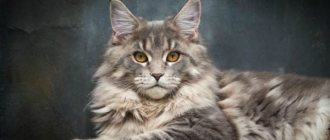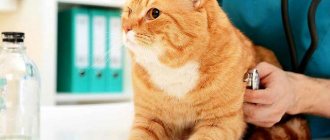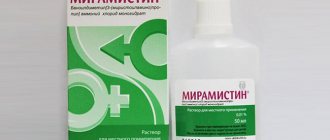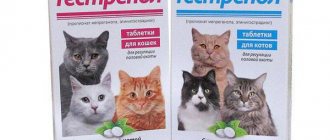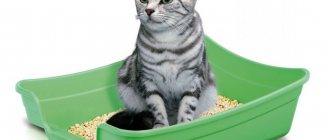Herpes in cats is an acute infectious disease that, if not properly treated, leads to rhinotracheitis. This virus gradually accumulates in cells as a result of decreased immunity, and then begins its dangerous march through the body. And only in your power to save your pet from such a misfortune. We will tell you further how to recognize herpes in the early stages and provide competent assistance to your cat.
Herpes in cats: symptoms and treatment
Methods of infection
Most often, infection occurs as a result of contact of an animal with a carrier of the disease. Contact is possible while walking, while visiting institutions, while traveling on public transport, and so on. The virus is transmitted:
- contact method - from a piece of clothing, furniture, bedding, trays;
- sexually - as a result of contact of mucous membranes.
Kittens are at risk of contracting the virus through their mother's milk
A kitten can get sick even at the very early stages of its life, because the virus is released from its mother’s milk. This is a nutritional route of infection through the mouth. Unfortunately, kittens less than one month old rarely survive herpes, since the newborn body cannot resist such a disease.
What kind of disease is this
Herpes in cats is caused by the FHV-1 virus. Otherwise, the disease is called rhinotracheitis and is divided into infectious, herpesvirus and viral. It can occur in an acute form or become chronic.
Cats are vaccinated against this infection, otherwise it affects most animals. Mortality ranges from 5-20%.
The virus is transmitted from a sick or recovered animal aerogenously. Can enter the body through food, water, milk, urine, through secretions from the eyes, nose and genitals. A person who has been in contact with an infected cat can also infect a pet.
Important! After recovery for up to 9 months, the cat releases the virus into the air.
The intensity of transmission depends on the duration of contact with the infected animal and the severity of its disease. Within two days after infection, the pathogen is detected in the discharge from the eyes and nose. It actively spreads for about 3-4 weeks.
If the cat is a latent carrier, then activation of the pathogen can begin under the influence of various factors: stress, pregnancy, illness. That is, any circumstances that reduce immunity can give rise to the disease.
Susceptibility to herpes
An animal of absolutely any age can become a target for the development of herpes. But kittens are most susceptible to developing the disease. Herpes spreads quickly throughout the body. This process occurs especially quickly if there are a large number of animals in one room. In nurseries, this disease becomes epidemic. If more than two individuals fall ill in one group, then there is a risk of rapid spread of the infection.
Herpes poses the greatest danger to kittens.
Susceptibility to disease is influenced by specific stress factors that increase the likelihood of infection. These factors include the following:
- hypothermia of the animal;
- poor sanitary and hygienic conditions;
- unbalanced diet;
- lack of vitamins that contribute to the growth and development of the body;
- stressful situations in which animals are subjected to rough physical impact.
Sometimes herpes can cause lack of heat
Types of disease progression
Modern medicine knows two types of progression of this disease:
- acute form: the course of the disease lasts about 14 days. The result, as a rule, is the recovery of the pet. Death is extremely rare. If the animal had a weak immune system at the time the virus was introduced or we are talking about a newborn kitten, then a fatal outcome is possible. A complication of acute rhinotracheitis is pneumonia;
If left untreated, the acute phase of the disease can develop into pneumonia
- Chronic rhinotracheitis lasts about 6 weeks. Its result is ulcerative keratitis, blindness or panophthalmia, depending on the circumstances and the specific organism.
Types of disease progression
Feline herpesvirus does not always follow a single pattern. In veterinary medicine, there are two main types of disease development:
- Spicy. The animal is sick for about two weeks. With proper treatment, the pet recovers, the likelihood of death is very low. Sad consequences are only possible if the cat’s immunity was severely weakened or if we are talking about a kitten under 1 month old.
- Chronic. If herpes is not diagnosed and treated in a timely manner, it can develop into rhinotracheitis. This dangerous disease lasts about six weeks and can lead to a number of consequences. Blindness, ulcerative keratitis or panophthalmia are possible.
Symptoms
During the first few days it is impossible to determine the presence of herpes: there is an incubation period. Only after a week does the cat begin to show the first symptoms. Most often, herpes appears on the lip or nose. An attentive owner may see small white bubbles. These are the initial signs of the disease.
In the initial stages, the disease is accompanied by other signs:
- non-healing ulcers in the nose or lips;
- swelling;
- slime;
- conjunctivitis.
Herpes often appears in the company of conjunctivitis
If you do not sound the alarm in time and do not go to the veterinarian, then the disease will progress to the acute stage within a few days. Unfortunately, in advanced stages the cat may die or develop a chronic disease.
Advanced stages have the following symptoms:
- temperature increase;
- lack of appetite;
- weakness;
- rapid heartbeat;
- heart failure;
- runny nose;
- salivation;
- nasal congestion;
- cough with sputum.
Untreated herpes causes serious heart complications
If you see that your animal’s condition is getting worse every day, you should urgently consult a doctor to prevent the development of other complex diseases. There are certain types of therapy that will help put an animal back on its feet, regardless of the stage of the disease.
Rhinoracheitis in cats: symptoms (with photos)
Most often, the presence of the virus is determined by the initial symptoms, which appear approximately 15 days after infection:
- lacrimation;
- nasal discharge;
- sneezing and coughing;
- copious mica secretion;
- blisters and ulcers on the mucous membranes and lips;
- weakness and apathy;
- decreased appetite;
- increase in body temperature.
Nasal congestion often makes cats reluctant to eat or drink, which can lead to general dehydration. In this case, the animals have to be force-fed.
Eyeballs
Important!
When infected with the virus, the organs of vision are affected and a characteristic symptom is inflammation of the eyes.
Inflammation is often accompanied by purulent discharge, which contaminates areas near the nose and eyes. The conjunctiva becomes swollen. The cat's eyelids stick together due to secretions, and the consequence of this is a narrow palpebral fissure.
On the lip
The herpes virus may lie low for a while and not manifest itself.
That is why its symptoms on the lip sometimes appear a week after infection.
In this case, small ulcers and blisters appear, which are filled with clear liquid.
Immunodeficiency virus
If the immune system does not respond to infection and does not fight the virus, then it begins to accumulate in the animal’s cells. Thus, the cat becomes a carrier and releases the virus into the external environment.
Symptoms of immunodeficiency virus in cats:
- enlarged lymph nodes;
- stomatitis;
- diseases of the genitourinary system;
- damage to the nervous system.
Diagnosis of herpes
Unfortunately, you cannot diagnose your pet on your own. He must be examined by a veterinarian, who will take tests, conduct a survey and, based on the data obtained, give a conclusion about the disease.
Only a specialist can determine the diagnosis and draw up a treatment plan for herpes.
Particular attention is paid to the symptoms and appearance of the animal. During a clinical examination, the doctor examines the animal’s mucous membranes and checks its reactions to exposure to individual areas of the body. In order to confirm the diagnosis, you need to take mucous secretions for analysis. Sometimes a descriptive blood test may be needed.
To identify the disease, the doctor takes the pet’s mucous secretions for analysis.
We will get acquainted further with the stages that the owner and his pet will have to go through during the examination.
Table. List of diagnostic procedures
| Manipulation | Description |
| Anamnesis | The doctor collects information about how the disease develops based on the story of the animal owner |
| Inspection | Using an external examination, the doctor checks for the presence of an ulcer, as well as accompanying symptoms. |
| PCR | Test to identify viral DNA |
| Antibody test | An immunofluorescence test is done to detect the presence of antibodies in the body |
| Scraping discharge from throat, nose, eyes | The presence of the virus is detected from mucosal samples |
| Blood analysis | Taken on an empty stomach from the vein of an animal |
If there is a latent form, without acute symptoms, then it is almost impossible to diagnose the presence of herpes. Therefore, cat owners should only contact a veterinarian if there are obvious signs.
Before herpes becomes obvious, it is very difficult to detect it
Differential diagnosis
Unfortunately, inexperienced veterinarians can often confuse rhinotracheitis with other diseases. The most common of them is calcivirosis. The symptoms of these diseases are similar. However, different pathologies require different treatments. Calcivirosis is a disease that, like rhinotracheitis, affects the upper parts of the respiratory system. It occurs due to the lack of vaccination against calcivirus. The only way to determine what disease has affected your cat is through a blood test.
Only an animal blood test will allow an accurate diagnosis to be made.
What is herpes virus infection
Herpes in cats or rhinotracheitis is an infectious disease. This is a virus that affects the upper respiratory tract of an animal, the mucous membranes of the nose, pharynx and eyes, causing inflammation. The general functions of the body are inhibited.
Herpesvirus in a cat
There are several ways that infection can enter an animal’s body: airborne, through food, through secretions of the genitourinary system, through the mucous membranes of the eyes and nose. Herpes in kittens is transmitted through mother's milk.
Is feline herpes transmitted to humans? No, cat herpes is not dangerous for humans. But humans can be a carrier of this disease between animals. For example, if you had contact with a viral cat.
Cats of different breeds can become infected with the herpes virus. The risk group includes small animals and animals with immunodeficiency. The virus is easily transmitted, so if several cats live in a room, there is a high probability that everyone will get herpes. Cat disease in catteries is turning into a real epidemic.
There is an opinion that cats of flat-faced breeds are more susceptible to the disease. But there are no official statistics on this matter.
The incubation period for this disease is from two days to a week. A herpes virus infection in cats can remain in the body for up to three weeks. There are situations when an animal is a latent carrier of herpes. The virus can be activated by stress, decreased immunity, hypothermia or overheating of the body, improper care, poor nutrition and vitamin deficiency, and rough handling.
Treatment
The treatment process is very difficult and can take a long time. Do all the necessary tests and re-examine. The veterinarian should warn the owner that treatment of herpes can only be done in acute manifestations. In this situation, the symptoms are pronounced and the best therapy can be selected.
Despite its fairly harmless manifestations, herpes is a serious disease.
You should not resort to self-medication, especially using folk recipes. Herpes can become a very dangerous disease with serious consequences. Therefore, a timely visit to the doctor is necessary.
The main goal of therapy is to restore immunity with subsequent destruction of the virus. Most often, therapy takes place in two stages.
- The first stage involves protecting the mucous membranes from damage and further development of inflammation. For this purpose, ointments are used that have an antiviral effect. The most common and effective of them is Acyclovir. The doctor may insist on placing ointment under the lower eyelid if the cornea is severely damaged. But “Tetracycline ointment” is best suited for this. The procedure must be carried out up to 6 times a day for 5-7 days.
Acyclovir ointment will relieve inflammation from the affected area
- The second stage includes antiviral therapy using Acyclovir orally. To do this you need to purchase tablets. This drug is given with the permission of a veterinarian. Unfortunately, many cats can be susceptible to liver dysfunction when taking these drugs. Therefore, it is necessary to correctly calculate the dose and monitor the pet’s condition during the first few hours after taking the drug. Do not forget that the animal’s immunity is greatly weakened. This means you will need good vitamin therapy. Ask your veterinarian to prescribe a B complex of vitamins A, C.
The second stage of treatment involves replacing the ointment with tablets
Veterinarians focus on taking sedatives. Don't forget about the most important procedures. The affected areas should be washed with a cotton pad. You can soak it in Miramistin, potassium permanganate or a homemade decoction of calendula and chamomile. This procedure must be carried out 3 to 5 times a day.
Calendula decoction has a gentle effect on the affected areas and promotes their healing
Proper feeding during treatment is of great importance. You should exclude junk food from the animal’s diet, increase the number of meals up to three times a day, in small portions. You should also offer your animal water more often. If the cat refuses to eat, you will have to force it using liquid or semi-liquid food.
During treatment, emphasis should be placed on the pet's consumption of quality water.
In order to suppress the growth of microflora, it is necessary to prevent the development of inflammation. For this purpose, antibacterial drugs are used, for example, Tylosin.
Farmavir stops the virus from wandering around the body, preventing the proliferation of infected cells
Additionally, the veterinarian prescribes medications that also effectively fight viral infections. Farmavir penetrates cells that have been infected by the virus and blocks the reproduction of their DNA. “L-Lysine” is the amino acid lysine A, which also prevents the proliferation of viral cells. "L-Lysine" displaces the virus from the body, preventing the possibility of its return.
Video - Principles of treatment of rhinotracheitis
How is mucous membranes washed?
Washing the affected mucous membranes is a mandatory procedure for an infected cat. For rinsing, it is recommended to use various solutions and decoctions listed above. Potassium permanganate, calendula decoction, even boiled water are perfect for this procedure.
Cats rarely tolerate instillation of drops calmly
You need to choose, after consulting with your doctor, exactly the solution that your pet currently needs. Most likely, the cat will resist such a procedure, because it gives her pain and discomfort. Therefore, if the cat is in a fairly active state, we recommend wrapping it in a towel or diaper, like a child. Place the animal on your lap, securing it with your left hand.
An example of proper swaddling of a cat
Meanwhile, take a clean cotton pad and soak it in the solution. Squeeze the disc slightly to prevent large drops from dripping off it. Using gentle, blotting movements, wipe the affected areas and the area around them. The procedure can be carried out several times in a row. After this, wait a few seconds for the solution to absorb a little. You can let the cat go. In order to achieve the effect, it is recommended to carry out this procedure at least 3 times a day.
We'll talk about how to securely wrap a cat in a towel, avoiding encounters with your pet's sharp claws and teeth.
Wrap the cat in a towel
How long does the virus stay in the body?
If more than one animal lives in your house or you are worried that if an infected person comes into contact with family members and small children, herpes will spread to someone else, then you need to study information about the timing of the development of the disease.
Even after treatment is completed, the cat remains a carrier of the herpes virus for several weeks.
After treatment for herpes, the animal begins to secrete viral cells in saliva, eye fluid, urine and from the nose. The virus is released within 3 weeks. The period must be taken into account from the moment the symptomatic signs ceased. However, by licking its fur, a cat contributes to the spread of infection, which persists on the fur for quite a long time.
It is impossible to completely cure herpes, but its acute stage can be prevented
The virus does not leave the animal’s body completely, it simply loses its severity. It is important to follow preventive measures in order not to provoke a relapse of the disease.
Only the best for your pets
Rhinotracheitis or herpes in cats is a viral respiratory disease caused by the herpes virus. The disease is accompanied by various symptoms. Among them, it is worth highlighting increased body temperature, runny nose, difficulty breathing and even damage to the visual organs. If a pet has a weak immune system, then it becomes a carrier of this virus, which increases the risk of infecting household members. Given these risks, it is worth carefully considering herpes in cats symptoms and treatment.
Herpes in a cat
Complications
Untimely or incorrect treatment leads to serious complications that will forever leave a mark on your pet’s health. The most common ailments caused by herpes include the following:
- pneumonia;
- “dry eye” syndrome, which is a consequence of infection of the lacrimal gland;
- corneal necrosis, keratitis as a result of improper functioning of the immune system;
- scarring of eye tissue;
- the appearance of ulcers;
- conjunctivitis.
about possible eye diseases in cats in a separate article on our portal.
Dry eye syndrome causes a cat to scratch its eye, causing injury to it.
The peculiarity of the virus is that, once settled in your pet’s body, it remains dormant throughout the pet’s life. Therefore, you should always be prepared for complications and resort to prevention methods.
Reasons for appearance
Often, the herpes virus in cats is transmitted by airborne droplets. The main sources are discharge from the pet's mouth and nose. It is not necessary to have contact with an infected animal. A domestic cat can catch the virus from the shoes and clothes of the owner who was near the patient. Herpesvirus is also transmitted by insects. The virus is transmitted transplacentally. In other words, it passes from an infected cat to its offspring.
Herpevirus type 1 is capable of remaining in the environment for a long time. The main condition for its existence is sufficient air humidity. However, it can be contained in soil and grass, which significantly increases the risk of infection of animals.
It is almost impossible to get rid of the disease completely. As a result of treatment, all symptoms are eliminated. The virus itself remains in the pet’s body. It is completely harmless to others, but can be activated as a result of stress or other related factors. Most of it is concentrated in the trigeminal nerve.
The following factors contribute to the appearance of herpes in cats:
- weak immunity;
- hypothermia and overheating of the body;
- non-compliance with the rules for keeping pets;
- large crowds of animals;
- abnormal nutrition.
The combination of these factors significantly increases the risk of infection for your pet. Therefore, you should carefully monitor its nutrition and content.
Precautionary measures
There are certain rules that allow animals to avoid herpes. Very often, owners forget that the cat must be vaccinated against a number of diseases, including herpes. The animal must have a special passport, where data on vaccinations performed is entered annually. If you still don’t have such a book, be sure to buy it, regularly vaccinate your pet and visit a veterinarian twice a year.
It is important not only to get useful vaccinations, but also to keep records of them
In order to protect the animal from the development of rhinotracheitis, it is necessary to use polyvalent vaccines. These include the following drugs:
- "Corifelin."
- "Multifec."
- "Quadricate".
The drugs are stored in ampoules and administered intravenously to cats.
Even if after the vaccine the animal gets sick with rhinotracheitis for some reason, it will go away easier, in the absence of severe symptoms.
Don’t forget about disinfecting objects that a sick animal has interacted with:
- carefully handle cages, bowls, toys;
- use disinfectants and chlorine-containing compounds when washing the floor and cleaning the apartment;
A clean home will significantly reduce the risk of infection entering your pet’s body.
- if your house contains several animals that have had rhinotracheitis, then give preference to separate living for a while;
- When walking, limit your pet’s contact with other animals if possible.
Differential diagnosis
Rhinotracheitis in cats: symptoms and treatment at home
When the first signs of herpes appear, the cat should be shown to a specialist as soon as possible. The symptoms of rhinotracheitis are similar to the symptoms of calcivirosis. This disease also affects the upper respiratory tract. As viruses mutate, it becomes increasingly difficult to distinguish them from each other. The most reliable test for identifying the virus is a blood test.
Diagnosis of the disease takes place in several stages:
- conversation between the doctor and the owner of the animal to obtain a complete picture of the medical history;
- visual and tactile examination for the presence of skin and mucous lesions;
- taking a PCR test to determine the type of virus;
- taking an analysis for the presence of antibodies to the disease in the animal’s body;
- taking scrapings from the mucous membranes of the throat, nose and eyes.
With the help of such diagnostics, the veterinarian will identify herpes in cats, symptoms and treatment.
Nutrition
If your cat has been eating dry food all the time, then during the illness you should think about switching to liquid food from the same company or choosing food rich in vitamins and minerals to quickly restore immunity. If the animal initially ate natural food, then the following dishes should be added to the diet:
- thin soup;
- meat puree;
- pate processed with boiling water;
- boiled fish (without bones);
- mashed vegetables.
Soups will help the cat replenish the supply of missing vitamins in the body.
Change the drinking water in your pet's bowl three times a day. Avoid cat treats sold in stores during treatment. You should not break the diet and offer your animal human food, even if you want to please your pet. You can read more about products harmful to cats

